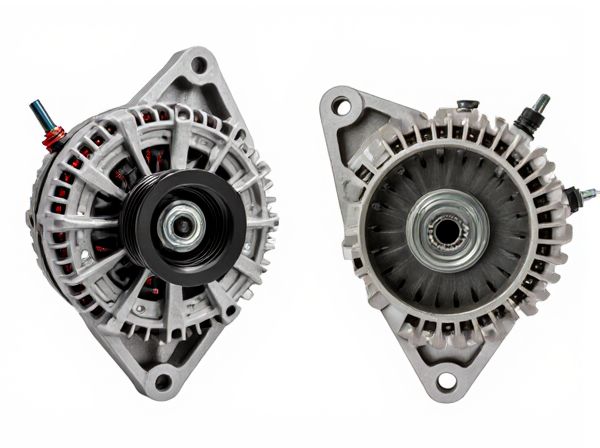
Photo illustration: Iron Core Stator vs Composite Core Stator
Iron core stators offer excellent magnetic conductivity and durability, making them ideal for high-performance electric motors with consistent efficiency. Composite core stators provide lighter weight and reduced eddy current losses, enhancing energy efficiency and thermal management in applications requiring lower weight and quieter operation. Your choice depends on prioritizing either mechanical strength and conductivity or weight savings and noise reduction in your motor design.
Table of Comparison
| Feature | Iron Core Stator | Composite Core Stator |
|---|---|---|
| Material | Ferromagnetic Iron | Composite non-metallic fibers |
| Weight | Heavier | Lighter |
| Magnetic Efficiency | High magnetic permeability | Lower magnetic permeability |
| Durability | Prone to corrosion and wear | Corrosion-resistant, longer lifespan |
| Thermal Performance | Good heat dissipation | Moderate heat dissipation |
| Cost | Lower manufacturing cost | Higher cost due to advanced materials |
| Noise & Vibration | Higher noise and vibration levels | Reduced noise and vibration |
| Application | Standard automotive alternators | High-performance and lightweight vehicles |
Introduction to Stator Core Technologies
Iron core stators utilize laminated steel sheets to reduce eddy current losses and provide high magnetic permeability, making them ideal for efficient electromagnetic flux conduction in electric motors. Composite core stators, combining soft magnetic materials with polymer matrices, offer advantages such as reduced weight, improved thermal insulation, and minimized eddy current losses at higher frequencies. Advancements in these stator core technologies focus on optimizing magnetic performance, thermal management, and manufacturing cost to enhance motor efficiency and durability.
What is an Iron Core Stator?
An iron core stator consists of laminated iron sheets designed to concentrate and direct magnetic flux within electric motors, enhancing magnetic efficiency and reducing energy losses. This type of stator provides high magnetic permeability, which improves electromagnetic performance in applications like induction motors and transformers. Its construction minimizes eddy currents and hysteresis losses, making it ideal for heavy-duty industrial equipment requiring consistent torque and power output.
What is a Composite Core Stator?
A composite core stator is an advanced electrical machine component made from non-metallic, fiber-reinforced materials instead of traditional iron, resulting in significantly reduced eddy current losses and improved thermal insulation. These stators offer higher efficiency and lighter weight compared to iron core stators, making them ideal for high-speed electric motors and applications requiring enhanced electromagnetic performance. Composite core technology also enables better noise reduction and increased mechanical strength, extending the operational lifespan of electric motors.
Material Composition and Properties
Iron core stators are primarily made from laminated silicon steel, which offers high magnetic permeability and excellent electrical conductivity, reducing core losses and enhancing electromagnetic performance. Composite core stators utilize a combination of materials such as fiberglass, epoxy resins, and powdered iron, resulting in lower weight, improved corrosion resistance, and better thermal insulation compared to traditional iron cores. The choice between iron and composite cores significantly impacts the stator's efficiency, durability, and suitability for applications requiring specific mechanical and thermal properties.
Magnetic Performance Comparison
Iron core stators exhibit superior magnetic permeability and lower core losses, resulting in enhanced efficiency and stronger magnetic flux density compared to composite core stators. Composite core stators, composed of laminated or powdered materials, reduce eddy current losses and provide better thermal stability but typically have lower magnetic saturation levels. The choice between iron and composite cores significantly impacts the overall magnetic performance, with iron cores favored for high-power, high-efficiency applications and composite cores preferred in lightweight, noise-sensitive, or high-frequency environments.
Efficiency and Power Losses
Iron core stators exhibit higher magnetic permeability, resulting in improved efficiency due to reduced core losses compared to composite core stators. Composite core stators, made from laminated or composite materials, offer lower eddy current losses, which enhances performance at higher frequencies but may have slightly increased hysteresis losses. Overall, the choice between iron core and composite core stators impacts power losses and efficiency depending on operational frequency and thermal management requirements.
Thermal Management and Heat Dissipation
Iron core stators exhibit higher thermal conductivity, enabling efficient heat dissipation during heavy load operations, but they are prone to eddy current losses that generate additional heat. Composite core stators utilize non-metallic, high-resistance materials that minimize eddy currents and thermal hotspots, enhancing thermal management in high-frequency applications. Effective heat dissipation in composite cores extends the lifespan and performance stability of electric motors by maintaining lower operating temperatures compared to iron core equivalents.
Weight and Structural Considerations
Iron core stators typically exhibit higher weight due to the dense ferromagnetic material, which enhances magnetic flux but increases overall mass. Composite core stators utilize lightweight materials such as epoxy and fiberglass, significantly reducing weight while maintaining adequate mechanical strength. Structural considerations favor composite cores in applications requiring vibration resistance and corrosion protection, whereas iron cores provide superior magnetic properties for high-performance motors.
Cost and Manufacturing Complexity
Iron core stators offer lower manufacturing costs due to simpler production processes and readily available materials, making them suitable for budget-sensitive applications. Composite core stators, while more expensive to produce, provide advantages in weight reduction and improved magnetic properties, but require advanced manufacturing techniques and higher material costs. The complexity of producing composite cores increases overall expenses, limiting their use to specialized, high-performance electric machines.
Applications and Future Outlook
Iron core stators are widely utilized in heavy industrial motors and power generation due to their high magnetic permeability and durability, making them suitable for applications requiring strong magnetic fields and efficient energy conversion. Composite core stators, integrating materials like glass fiber or carbon fiber reinforced polymers, offer advantages in weight reduction and lower eddy current losses, positioning them favorably for electric vehicles, aerospace, and renewable energy sectors demanding lightweight and thermally stable components. Future outlook indicates increased adoption of composite core stators driven by advancements in material science and manufacturing technologies, promising enhanced efficiency and sustainability in emerging high-performance and energy-sensitive applications.
 caratoz.com
caratoz.com